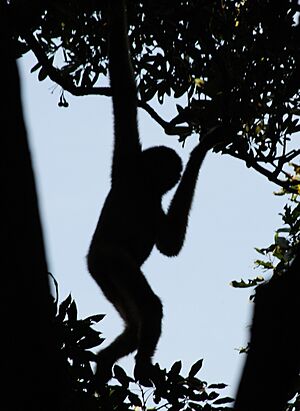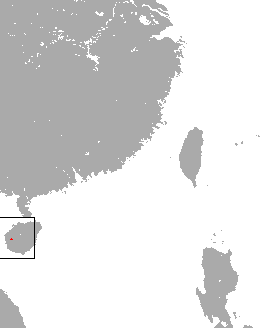Hainan black crested gibbon facts for kids
Quick facts for kids Hainan gibbon |
|
|---|---|
 |
|
| Conservation status | |
| Scientific classification | |
| Genus: |
Nomascus
|
| Species: |
hainanus
|
 |
|
| Hainan gibbon range | |
The Hainan gibbon (Nomascus hainanus) is a special type of gibbon. It is found only on Hainan Island in China. This animal is one of the most Critically Endangered species on Earth.
Scientists used to think it was a type of eastern black-crested gibbon. But now, they know it's its own unique species. This is because of differences in their bodies and the sounds they make. Hainan gibbons live in forests with many different kinds of trees. They mostly eat sweet, ripe fruits like figs. They also eat leaves and insects sometimes.
Contents
Why the Hainan Gibbon is in Danger
The Hainan gibbon is in serious danger of disappearing forever. It is listed as "critically endangered" by the International Union for Conservation of Nature. This means there are very few left.
Long ago, these gibbons lived across a large part of China. But their numbers have dropped a lot in the last 50 years. In the 1950s, there were over 2,000 gibbons on Hainan Island. By 2004, only about 12 to 19 were left.
Today, there are only about 22 Hainan gibbons known to exist. They live in the Hainan Bawangling National Nature Reserve. They are split into two family groups and a few lone males.
The biggest reason for their decline is that their homes are being destroyed. People are cutting down forests to make paper plantations. This means the gibbons have less space to live and find food. Poaching, which is illegal hunting, has also been a problem. Because there are so few, one big storm or disease could wipe them out.
Physical Features and Life Cycle
Hainan gibbons look different depending on if they are male or female. This is called sexual dichromatism. Males are almost completely black. Sometimes they have white or light brown cheeks.
Females are golden or light brown. They have black patches, including a black stripe on their head. Both males and females are thin. They have long arms and legs, but no tail. They use their long arms to swing through trees. This way of moving is called brachiation. Hainan gibbons also sing special songs together. These songs help them bond and find mates.
Reproduction and Family Life
Hainan gibbons have changed how they reproduce because their habitat is so small. The few gibbons left often live in polygynous families. This means one male lives with two adult females and their babies.
This family setup helps them have babies more often. They have a baby every two years. This is faster than most other gibbon species. It also matches when fruits are ready on Hainan Island. Their gestation period, which is how long the mother is pregnant, is also shorter than other gibbons.
Where Hainan Gibbons Live
Hainan gibbons live in three types of forests on the island. Their main home is the primary forest. These forests have tall trees, often over ten meters high. These trees give them shelter and places to sing. Primary forests also have at least six types of plants that gibbons eat.
When primary forests are cut down, it takes a very long time for the trees to grow back. In the 1960s, many lowland forests on Hainan were cleared. This was for rubber plantations and logging. This forced the gibbons to live in higher, less suitable areas. By 1999, only 4% of their original home was left.
Gibbons also spend some time in secondary forests and dwarf forests. Secondary forests are not as good as primary forests. Their trees are shorter, and there is less food and shelter. Dwarf forests are even worse for gibbons. They spend very little time there. But they do use dwarf forests to travel between primary forests. Even with these other forest types, destroying primary forests still hurts the gibbon population a lot.
Threats from Humans
When their habitat is destroyed, Hainan gibbons have less food and shelter. Most of the original plants on Hainan Island have been lost due to deforestation. Pine and fir trees have replaced them. These trees do not provide enough food for the gibbons.
While hawks have tried to attack young gibbons, humans are the biggest threat. The number of people on Hainan Island grew very fast between 1950 and 2003. This growth led to more roads and towns. These projects destroyed gibbon homes. They also split gibbon groups, making them isolated.
Some people try to catch gibbons illegally. A female gibbon can be worth a lot of money. Gibbon bones are also used in traditional medicine. This led to many hunts between 1960 and 1980, killing about 100 gibbons. Also, many local people rely on the forests for firewood, food, and herbs. This further harms the gibbons' environment.
Why Hainan Gibbons are Important
The Hainan gibbon is called an "umbrella species" for Hainan Island. This means that if the Hainan gibbon is healthy, it shows that the whole ecosystem is healthy. If something bad happens to the gibbons, it likely affects other species too.
Other types of gibbons help spread seeds for many plants, especially figs. So, if the Hainan gibbon disappears, it could make it harder for native plants to grow back. No gibbon species has gone extinct in modern times. Scientists are still learning about how important the Hainan gibbon is to its environment.
Protecting the Hainan Gibbon
Challenges in Reproduction
It is hard for the Hainan gibbon population to grow quickly. Breeding females have only one baby every two years. The baby stays with its mother for about a year and a half. Also, there are no Hainan gibbons living in zoos or other captive places. All past attempts to breed them in captivity have failed.
Conservation Efforts
To help the Hainan gibbon, a special plan was made in 2003 and updated in 2005. Many groups worked together on this plan. These included the Hainanese and Chinese governments, Kadoorie Conservation China, and Fauna and Flora International (FFI).
The plan aims to stop habitat loss. It suggests having more patrols to stop illegal logging. It also recommends turning old farms back into forests. They want to plant trees that gibbons need for food, like figs. The plan also focuses on teaching local people why the Hainan gibbon is important.
Groups like Greenpeace and FFI are working to raise awareness about the gibbons. They want people in Asia and around the world to know about their plight. However, the current plan needs more money and better support from the groups involved. Greenpeace is urging Hainan to enforce its laws against poaching and logging more strictly.
See also


